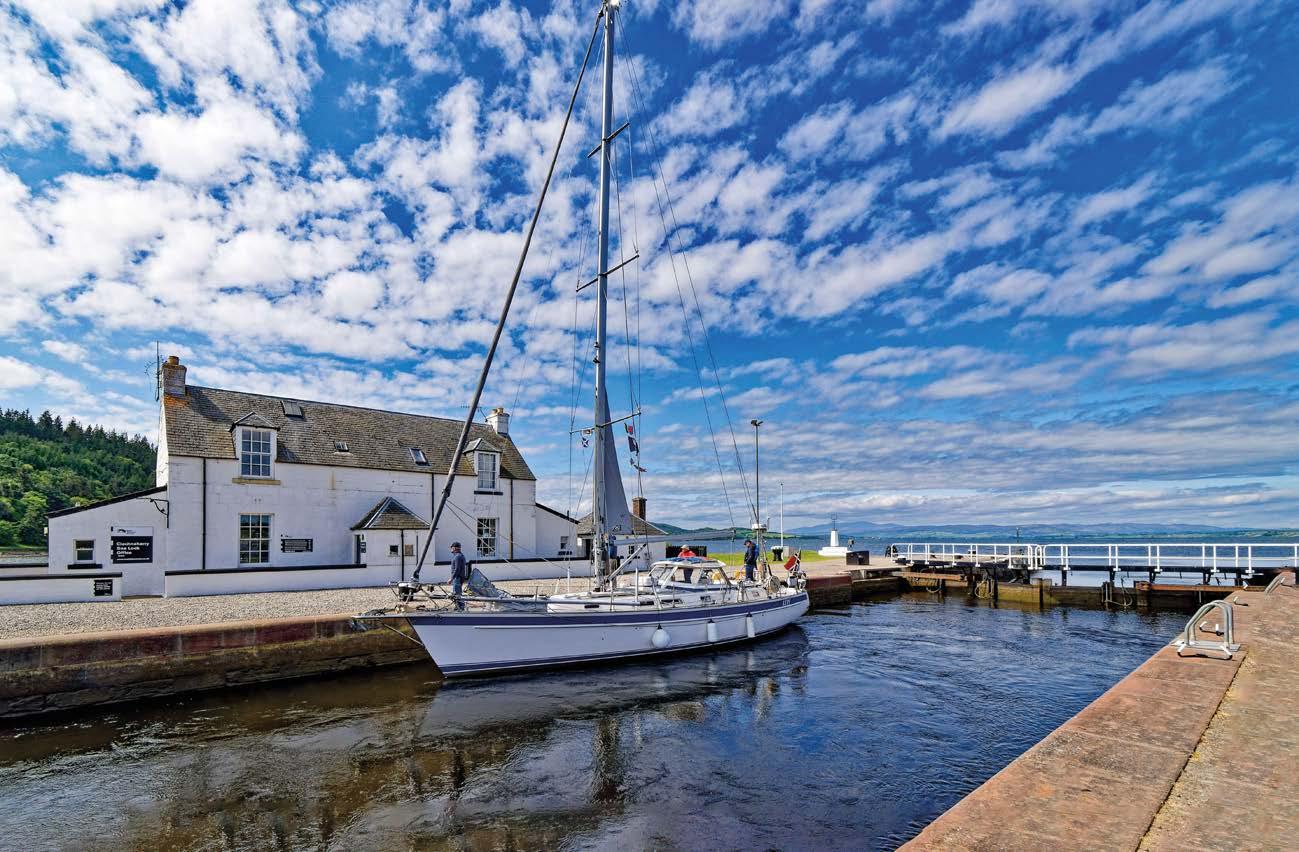
4 minute read
Notes from the Isles
ABOVE: Kate and Cronie, her faithful Border Terrier
OPPOSITE PAGE: A yacht waiting to enter the Caledonian Canal sea locks in early summer
Words by KATE FRANCIS
My brother-in-law, David, a widower for three years, was still at school when my parents-in-law bought this dear old farmhouse in 1952, and he shares my love of the Highlands despite living in England and having spent a nomadic life as a diplomat.
Recently, David decided to organise an octogenarian jaunt for some of his contemporaries from Oxford; the plan was to lure them north and take them on a tour of his favourite places. There were eight of them, plus him, and my daughter Mary was their tour guide for a week – something she is well quali ed for, as an architectural historian and writer.
They had a bus and driver and began their expedition from Inverness – having once written a tourism guide to the Highlands and Islands, I couldn’t fault David’s itinerary. Day one included Culloden Battle eld and its excellent visitor centre; 14th-century Cawdor Castle and gardens; and the amazing Bronze Age burial site at Clava Cairns, where excavations revealed cremated bodies, pottery and other memorials of people who lived 4,000 years ago.
That night they came here for supper, to inspect their host’s childhood home. (My Douglas, being several years older, had already joined the army when the family came to live here so he never had a room of his own, just a bed in a corrugated iron shed in the garden with no mod cons). David insisted that, rather than coming to the back door, where it’s possible to park cars, and in through the kitchen, the group would arrive through the front gate, up the paved path, over the terrace and in through the front door. I did some super cial weed-snapping between the paving stones and cut back a cornus so that they didn’t have to crawl through the gate on hands and knees, and they seemed suitably impressed by my ‘wild’ garden. There were 11 of us and it was like a delightful gathering of prep-school alumni as they exchanged jokes and old stories round the table. I hope everyone enjoyed it as much as I did. They all had second helpings of my coronation chicken and blueberry cheesecake.
Having had their Jacobite education at Culloden, the next day they went to the Wardlaw Mausoleum, built for the Lovat Frasers in 1634. Simon Fraser, 11th Lord Lovat, known as the Old Fox and famous for his somewhat devious loyalties to both the House of Hanover and the Stuart cause, nally supported the Jacobites. For this, he was arrested, taken to the Tower of London, and executed in 1747.
Simon Fraser was buried in London, but his family nally managed to transfer what they believed to be his cof n to Wardlaw so he could rest in peace with his ancestors. However, when the double-leaded casket was opened not long ago, it contained the skeleton of a woman, with no head, and some children’s bones. There are many theories for this enigma but it hasn’t been solved yet and the whereabouts of the Old Fox is still a mystery.
The group nished their tour up in Skye, with plenty of historic sites to visit, including the Clan Donald Centre and Museum at Armadale Castle – a necessary part of the tour because the Macdonalds gave David his Scottish blood – and Dunvegan, seat of Clan MacLeod, the oldest continuously inhabited castle in Scotland.



My favourite relic at Dunvegan is the Fairie Flag, a tattered silk 4th-century relic, with many differing stories of its origins. Thought to be Syrian, it might have been brought back from a Crusade to the Holy Land, by a MacLeod chief. Whatever it’s provenance, it’s believed to have the power to bring victory in war to its bearers and has already done this twice for the MacLeods in their defeat of the Macdonalds. However, it has a limit of three uses, after which it will bring disaster.
Sitting here on my terrace, basking in sunshine, and serenaded by birdsong, it seems impossible to imagine that there could ever be another reason to wave the Fairie Flag. Gazing across a mirror-like firth dotted with sailing boats, to hills so recently snow-capped, I marvel yet again at those of my neighbours who choose to pay a fortune to queue for hours at airports and then spend a couple of weeks on a crowded beach abroad. Walking along the shore with Cronie this morning, I was filled with joy at being so lucky to live here; there’s no other place where I would rather be.
The briars are in full, aromatic bloom: pink, white, and creamy, with foxgloves – and of course thistles – pushing up among them. An otter was so engrossed in devouring a fish that it didn’t run away when we passed. Herons stood vigilant on the rocks; a flock of curlews flew out over the water, chased by shrieking oystercatchers; a motorboat full of tourists went past, looking for dolphins. Three yachts were queuing up in the distance, to enter the first lock of the Caledonian Canal, thereby taking a short cut over to the west coast.

Scotland may seem perfect, but there are a couple of cons to the millions of pros: ticks and midges, both of which are particularly abundant this year. Bracken, heather and deer are among the favoured hosts to ticks and these are prevalent on most of Cronie’s and my walks. My blood must be especially delicious, because I seem to return from each walk infested with them, although they’re easy to evict when visible, they tend to go for the most inaccessible parts of the body, from where it’s impossible to gouge them out.
Having once had Lyme’s disease I know one must be vigilant and I notice the tell-tale red ring that forms around the bite, but that’s tricky when the bite is out of sight. I’ve now invested in an anti-tick spray that you squirt all over yourself and that seems to be working – at least for the moment. For Cronie, there are pills, costing £40 for three! There’s nothing you can do about midges except swat them and be stoical. S



